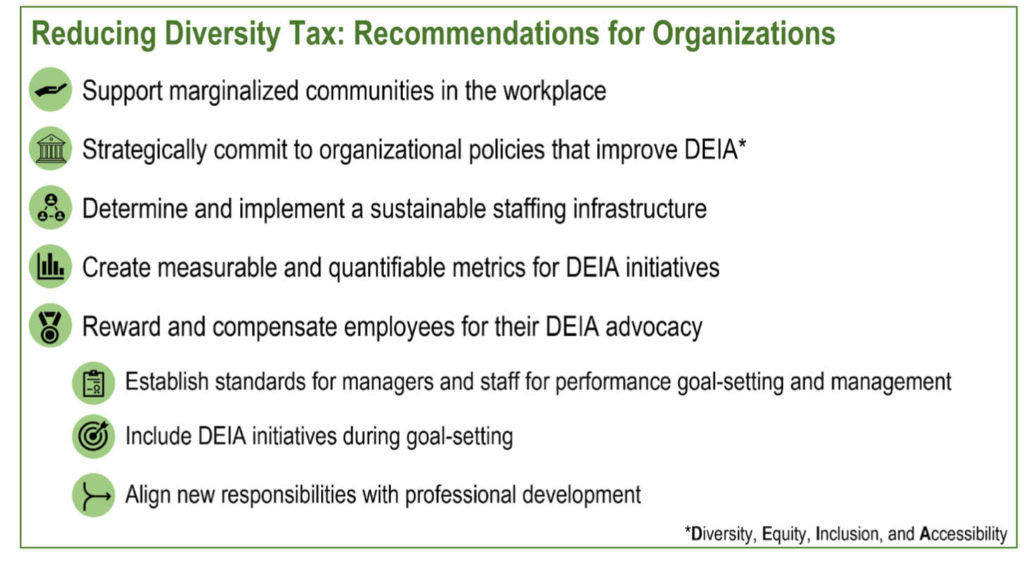Editor’s Note: This is the fourth in a series of posts that will run this week, written by Chhavi Chauhan, Shaina Lange, and Tony Chen. Chhavi is Director of Scientific Outreach at the American Society for Investigative Pathology (ASIP) and Director of the Continuing Medical Education (CME) Program at the Journal of Molecular Diagnostics. Shaina is Manager of the Publishing Integrity Office at ACS Publications. She oversees the strategy, policies, and activities to support publishing integrity across the ACS journals portfolio. Tony is a Journal Publishing Manager at Wiley, where he manages a portfolio of journals in Oncology, Pathology, and Basic Medical Science under the Health Sciences banner.
If you haven’t read the first 3 posts in this series, we encourage you to do so. In Parts 1, 2, and 3, we have explored diversity tax and reflected on its impacts on underrepresented minorities, shared tactics to alleviate the burden of affected individuals, and made recommendations for allies and managers to reduce the burden of diversity tax.
Today’s post will focus on how organizations can factor in diversity tax as they strategically approach diversity, equity, inclusion, and accessibility (DEIA) in their businesses. Meaningful change can come from the power of a small group of individuals, but sustained changes to the culture, systems, and protocols necessitates a strategic, focused approach from the highest levels of an organization.

Recommendations for organizations (including human resources (HR), managers, and leadership):
- Support marginalized communities in the workplace. DEIA advocacy is everyone’s responsibility, not just that of the individuals directly affected. As our previous posts have described, pushing the burden onto the people directly affected by the lack of DEIA creates an unfair “cultural” or “diversity tax”, leading to increased burnout and rapid turnover of marginalized employees. Intentional support for these colleagues is critical to decreasing the diversity tax burden on them.
- Strategically commit to organizational policies that improve DEIA. This requires intentional, focused policies specifically designed to make your organization more inclusive and equitable. For example: more paid and remote internships and job opportunities; an intentional focus on diverse candidates during hiring, including recruiting through national organizations supporting marginalized communities and from minority-serving institutions; using inclusive language in job descriptions; inclusive approaches to interviewing, such as ensuring that you proactively offering accommodations for candidates at request; resources and financial support for current marginalized employees, including support from colleagues at all levels of the organization.
- Determine and implement a sustainable staffing infrastructure. An inclusive culture necessitates consulting those from affected communities, but they should not be solely responsible for generating and carrying forward DEIA ideas. Too often, organizations rely on a small working group of volunteers to drive DEIA policy changes. For smaller organizations, those with limited resources, and/or those facing resistance from leadership, grassroots or volunteer-driven efforts may be the only option to initiate change; however, this places an inappropriate level of accountability and ownership on volunteers and creates risk when one key individual leaves or needs to step back. DEIA initiatives — especially those that involve staff policies, onboarding, and workplace adjustments — may require trained staff and/or specialized consultants to properly implement. Organizations should consider how DEIA goals overlap with existing business units (such as HR) and whether or not it makes sense to create a dedicated DEIA specialist position and/or team.
- Create measurable and quantifiable metrics for DEIA initiatives. Measuring and regularly sharing demographic metrics for your organization — including measurable goals and timeframes — is critical for organizations committed to DEIA. Similar to how the organization might approach a business challenge or gauge the effectiveness of a new pilot, DEIA initiatives should involve a goal- and metric-driven strategic approach. By defining the baseline, goals, and outlining tactics to reach those goals, the targets will be more attainable and efforts more sustainable. A lack of transparency creates doubt and poor optics for all involved, and is discouraging to DEIA advocates who don’t know whether their efforts are working.
- Reward and compensate employees for their DEIA advocacy, especially those from marginalized communities. It is not enough to state that DEIA is an organizational value if it’s not backed up by appropriate action. If an organization truly believes that DEIA is important for its people, mission, and business goals, then that must be reflected in its goal-setting and recognition/compensation systems. Embed DEIA principles into your annual goal-setting conversations and create DEIA-specific key performance indicators (KPIs) that everyone, including executives, are held accountable for. Ensure that employees from marginalized communities are rewarded appropriately for their DEIA work/advocacy. Reward and compensate employees for participating in DEIA initiatives, including but not limited to:
- Establishing standards for managers and staff for performance goal-setting and management. This includes the redistribution of regular responsibilities to provide bandwidth for leading these efforts, which should be recognized as time- and resource-intensive, and given the same importance as other projects.
- Including DEIA initiatives during goal-setting. Make sure contributions are recognized. Include DEIA-based goals/responsibilities/KPIs in performance reviews.
- Aligning these new responsibilities with professional development. Managers and organizational leadership can help marginalized communities by providing them with opportunities to represent their organization externally and publicly, especially with other stakeholders and in public settings. An important part of DEIA is creating an inclusive internal culture, and rewarding and crediting colleagues for their DEIA work is an essential part of creating that inclusive culture.
“It’s crucial to be able to compensate and recognize employees for this work. If your employee is being asked to pick up a DEI activity, their workload should be adjusted to compensate for this. It isn’t just a passion project, it’s important work that should be recognized as such.” — Anonymous Contributor

In making these recommendations to address diversity tax, especially where cultural and systemic changes are needed at larger organizations and within leadership, we acknowledge that each of these efforts comes with its own set of hurdles. Change always takes time — it won’t happen overnight; however, these recommendations are absolutely achievable and realistic if prioritized properly.
Hopefully, this series helped you understand the concept of diversity tax and appreciate the extent of its negative impact on individuals as well as organizations. To keep this conversation going and bring about tangible change, we invite feedback from individuals, organizations, and allies by answering the anonymous survey below and/or continuing the discussion in the comments. In a future post, we look forward to sharing the results and a summary of comments received.
Acknowledgements: We are grateful to our anonymous contributor for sharing their experiences and to the members (current and former) of the SSP DEIA committee for their feedback on this series of posts prior to publication.


